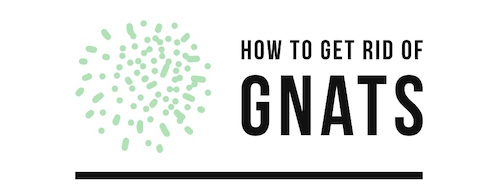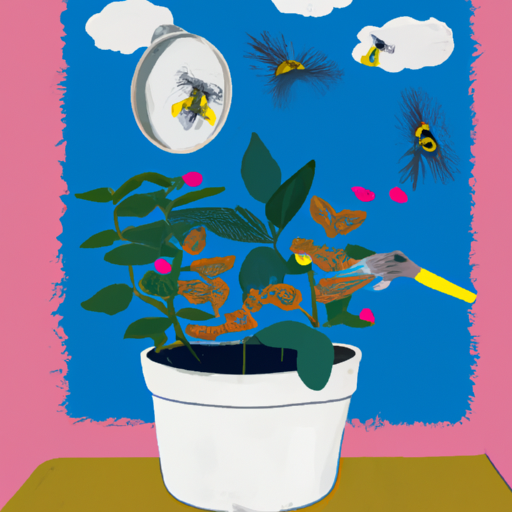How to Identify Gnats in Plants and What to Do About Them
Gnats are small, flying insects that can be found in and around plants. They are often mistaken for fruit flies, but they are actually different species. Gnats feed on the sap of plants and can cause damage to foliage and flowers. Identifying gnats in plants is important so that you can take steps to control them before they become a problem.
To identify gnats in plants, look for small black or gray insects hovering around the plant’s leaves or stems. They may also be seen crawling on the soil surface near the plant’s roots. If you see these insects, it is likely that you have a gnat infestation.
Once you have identified gnats in your plants, there are several steps you can take to control them:
1) Remove any decaying organic matter from around your plants as this will attract more gnats;
2) Use sticky traps or yellow cards to capture adult gnats;
3) Apply an insecticidal soap or neem oil solution directly onto affected areas of your plant;
4) Introduce beneficial nematodes into the soil which will attack larvae; and
5) Increase air circulation by pruning back dense foliage and using fans near affected areas of your garden.
By following these steps, you should be able to reduce the number of gnats in your garden and protect your plants from further damage caused by these pests.
Natural Ways to Get Rid of Gnats in Plants
Gnats are a common problem in houseplants, but they can be eliminated without the use of harsh chemicals. Here are some natural ways to get rid of gnats in plants:
1. Remove any decaying plant material from the soil and dispose of it properly. This will help reduce the number of gnats that may be present in your plants.
2. Increase air circulation around your plants by moving them away from walls and other objects that may block airflow. This will help prevent new gnat infestations from occurring.
3. Place yellow sticky traps near your plants to catch adult gnats as they fly around looking for food or mates. These traps should be replaced regularly to ensure effectiveness against new generations of gnats that may hatch over time.
4. Make a homemade insecticidal soap spray by mixing one tablespoon of dish soap with one quart of water and spraying it directly onto affected areas on your plants where you see signs of gnat activity (such as leaves or stems). Be sure to spray both sides of each leaf for maximum effectiveness against these pests!
5. Introduce beneficial nematodes into the soil surrounding your plant’s roots, which will feed on larvae and eggs found there, helping to reduce their numbers over time naturally without harming other beneficial insects or animals in the area like chemical treatments might do!
6 Finally, make sure you’re watering your plants correctly – too much water can create an ideal environment for these pests to thrive so make sure you’re not overwatering!
The Benefits of Using Insecticides for Controlling Gnats in Plants
Insecticides are a common and effective way to control gnats in plants. Gnats, also known as fungus gnats, are small flying insects that feed on the roots of plants and can cause significant damage if left unchecked. Insecticides can be used to kill adult gnats and larvae, preventing them from reproducing and causing further damage.
Insecticides come in many forms, including sprays, granules, dusts, baits and liquids. Sprays are the most common form of insecticide used for controlling gnats in plants because they provide quick coverage over large areas. Granules or dusts can be applied directly to the soil around the plant’s roots where they will slowly release their active ingredients over time. Baits contain attractants that draw adult gnats away from their food source so they can be killed by contact with the insecticide-laced bait material. Liquids are often used as a drench or foliar spray for treating larger infestations of adult gnats or larvae on foliage or stems of plants.
Using insecticides is an effective way to control populations of fungus gnat adults and larvae before they cause serious damage to your plants’ root systems. When using any type of insecticide it is important to read all instructions carefully before applying it according to label directions for best results. Additionally, it is important not to apply more than necessary since this could lead to environmental contamination or harm beneficial insects such as pollinators that may visit your garden area looking for nectar sources from flowering plants nearby
Tips for Preventing Gnat Infestations in Your Garden
1. Keep your garden clean and free of debris: Remove fallen leaves, weeds, and other organic matter from your garden to reduce the number of places where gnats can breed.
2. Water your plants in the morning: Gnats are attracted to moist soil, so watering in the morning will give the soil time to dry out before nightfall when gnats are most active.
3. Use yellow sticky traps: Place yellow sticky traps around your garden to attract and trap adult gnats before they can lay eggs in the soil or on plants.
4. Introduce beneficial insects: Introducing beneficial insects such as ladybugs, lacewings, and predatory mites into your garden can help control gnat populations by preying on their larvae and eggs.
5. Use insecticidal soap or neem oil spray: If you have a severe infestation of gnats, you may need to use an insecticidal soap or neem oil spray to kill them off quickly and effectively. Be sure to follow label instructions carefully when using these products in order to avoid harming beneficial insects or pollinators like bees and butterflies that may be present in your garden as well!
How to Use Beneficial Insects and Biological Control Methods for Getting Rid of Gnats
Gnats are small, annoying insects that can be difficult to get rid of. Fortunately, there are several beneficial insects and biological control methods that can help you eliminate them from your home or garden.
One of the most effective ways to get rid of gnats is by introducing beneficial insects into your environment. Ladybugs, lacewings, and predatory mites are all natural predators of gnats and can help reduce their population in your home or garden. Ladybugs feed on aphids, which often attract gnats; lacewings feed on both aphids and larvae; while predatory mites feed on the eggs and larvae of many different types of pests including gnats.
Another way to control gnat populations is through the use of biological control methods such as nematodes. Nematodes are microscopic worms that attack the larvae stage of many different types of pests including gnats. They can be applied directly to soil where they will seek out and destroy any pest larvae they find there.
Finally, you can also use sticky traps to capture adult gnats before they have a chance to lay eggs in your home or garden. These traps work by luring adult gnats with a sweet-smelling bait before trapping them on an adhesive surface where they will eventually die from dehydration or starvation.
By using these beneficial insects and biological control methods together with sticky traps, you should be able to effectively reduce the number of gnats in your environment without having to resort to chemical pesticides or other harsh treatments that could harm other beneficial organisms living in your area as well as yourself!

